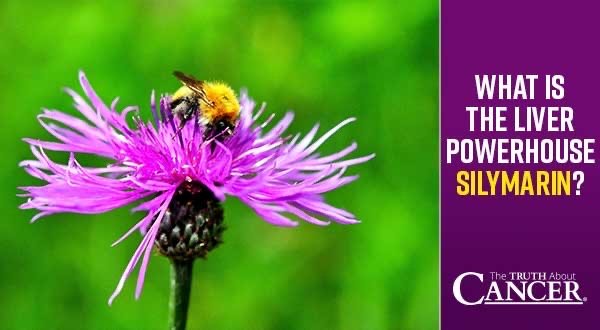© 2021 GreenMedInfo LLC. This work is reproduced and distributed with the permission of GreenMedInfo LLC. Want to learn more from GreenMedInfo? Sign up for the newsletter here //www.greenmedinfo.com/greenmed/newsletter.
When it comes to treating liver and gallbladder disorders, there is one name that stands out: silymarin. As a group of flavonolignans extracted from milk thistle, silymarin has been traditionally used for various protective benefits, from reinvigorating liver function to promoting breast milk production.
The milk thistle plant, scientifically known as Silybum marianum, is a prickly plant with purple flowers and milky white veins present on the leaves, thus its name. Silymarin is the group of plant compounds that act as its active ingredient.[i]
Silymarin is the main bioactive component of this medicinal plant. It is a mix of various flavonolignans, includings silybinin A and B, isosilybinin A and B, silychristin and silydianin.[ii] Milk thistle extract has a high silymarin content of approximately 65% to 80%.
Silymarin is famed for its antioxidant, antiviral and anti-inflammatory components,[iii] as well as its traditional use or treating the liver and restoring its health. In addition, milk thistle itself is generally considered safe to take. Side effects are rare, and in an oral form standardized to contain 70% to 80% silymarin, it appears to be safe for up to 41 months of use.[iv]
Silymarin’s Liver-Protective Effects
- Fights liver inflammation and liver damage. Mounting evidence shows improvements in liver function among people with liver diseases who have taken a milk thistle supplement.[v] This suggests protection against flavanone silibinin liver inflammation and liver damage through use of the natural — silymarin’s primary active component — which was combined with phosphatidylcholine in a specific study to enhance its solubility and bioavailability.
- Protects from toxins such as amatoxin, produced by Amanita mushroom, which can cause death if ingested. Two cases in the U.S. were treated with N-acetylcysteine, high-dose penicillin, cimetidine and silibinin.[vi]
Uncontrolled trials and case reports cited successful treatment with intravenous silibinin, a flavonolignan isolated from milk thistle extracts, in nearly 1,500 cases.[vii] Overall mortality in those treated with the formula was less than 10%, compared to more than 20%when using penicillin, or a mix of silibinin and penicillin.
- Reduces liver fibrosis. In a randomized trial of 99 patients, the team administered silymarin in 700-milligram (mg) doses, or a placebo, given three times daily for 48 weeks.[viii] Non-alcoholic fatty liver disease (NAFLD) activity score was reduced by 32.7% in the silymarin group compared to 26% in the placebo group.
Among the secondary outcomes were reductions in inflammation and fibrosis score in the silymarin group, leading the researchers to conclude that silymarin may decrease liver fibrosis, to be confirmed in larger trials. Fibrosis is the formation of abnormally large amounts of scar tissue in the liver.
- Helps prevent liver cancer. Studies have concluded that the long-term use of silymarin significantly increases survival time among patients with alcohol-induced liver cirrhosis, a risk factor for liver cancer. Silymarin can also significantly reduce tumor cell proliferation, angiogenesis or new blood vessel formation, as well as insulin resistance.[ix]
The chemopreventive effects “have been established in several studies using in vitro and in vivo methods,” according to the researchers, and combine well with anti-inflammatory and inhibitory effects on the metastasis or spread of cancer.
- Contributes to liver regeneration. An animal study suggested that silymarin played a crucial role in accelerating liver regeneration after liver resection, a kind of surgery designed to remove cancerous tumors from the liver.[x] Liver regeneration is thought to evolve to protect animals from loss of liver due to toxins or tissue injury.
Silymarin for Breastfeeding, Neurological Support
Not to be ignored is silymarin’s formidable list of other health benefits, such as boosting milk production in lactating mothers. A randomized trial found that mothers taking 420 mg of silymarin for 63 days produced more breast milk than subjects who took a placebo.[xi] Silymarin combined with phosphatidylserine and galega also increased milk production in moms of preterm infants, without any significant side effects.[xii]
Milk thistle is also a traditional remedy for neurological disorders such as Alzheimer’s and Parkinson’s diseases. Its antioxidant and anti-inflammatory action mean it may be neuroprotective and help prevent the brain decline experienced with aging.[xiii]
For more information, there are nearly 100 abstracts with silymarin research on the GreenMedInfo.com database, where you can discover more of its practical therapeutic benefits for your liver and whole body health.
References
[i] Abenavoli L et al “Milk thistle in liver diseases: past, present, future” Phytother Res. 2010 Oct;24(10):1423-32.
[ii] Aziz M et al “Biochemical profile of milk thistle (Silybum Marianum L.) with special reference to silymarin content” Food Sci Nutr. https://doi.org/10.1002/fsn3.1990
[iii] Kim M et al “Optimal management for alcoholic liver disease: Conventional medications, natural therapy or combination?” World J Gastroenterol. 2016 Jan 7;22(1):8-23.
[iv] Rainone F “Milk thistle” Am Fam Physician. 2005 Oct 1;72(7):1285-8.
[v] Polachi N et al “Modulatory effects of silibinin in various cell signaling pathways against liver disorders and cancer – A comprehensive review” Eur J Med Chem. 2016 Nov 10;123:577-595. Epub 2016 Jul 29.
[vi] Ward J et al “Amatoxin poisoning: case reports and review of current therapies” J Emerg Med. 2013 Jan;44(1):116-21. Epub 2012 May 1.
[vii] Mengs U et al “Legalon® SIL: the antidote of choice in patients with acute hepatotoxicity from amatoxin poisoning” Curr Pharm Biotechnol. 2012 Aug;13(10):1964-70.
[viii] Chan et al “A Randomized Trial of Silymarin for the Treatment of Non-alcoholic Steatohepatitis” Clin Gastroenterol Hepatol. 2017 Apr 15. Epub 2017 Apr 15.
[ix] Feher J et al “Silymarin in the prevention and treatment of liver diseases and primary liver cancer” Curr Pharm Biotechnol. 2012 Jan;13(1):210-7.
[x] Wu J et al “Silymarin Accelerates Liver Regeneration after Partial Hepatectomy” Evid Based Complement Alternat Med. 2015 ;2015:603529. Epub 2015 Aug 3.
[xi] Di Pierro F et al “Clinical efficacy, safety and tolerability of BIO-C (micronized Silymarin) as a galactagogue” Acta Biomed. 2008 Dec;79(3):205-10.
[xii] Zecca E et al “Efficacy of a galactogogue containing silymarin-phosphatidylserine and galega in mothers of preterm infants: a randomized controlled trial” Eur J Clin Nutr. 2016 Oct ;70(10):1151-1154. Epub 2016 Jun 1.
[xiii] Borah A et al “Neuroprotective potential of silymarin against CNS disorders: insight into the pathways and molecular mechanisms of action” CNS Neurosci Ther. 2013 Nov;19(11):847-53. doi: 10.1111/cns.12175. Epub 2013 Oct 14.



















Leave a Reply